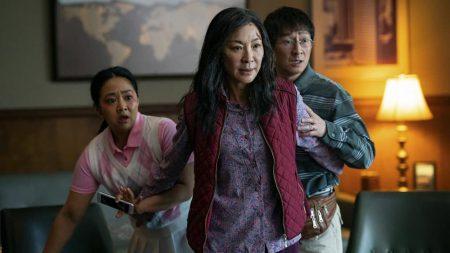
Photos courtesy of A24
CAMERON WEBSTER
campus editor
cameron.webster@my.tccd.edu
“Everything Everywhere All at Once” is akin to the boat scene from the original “Willy Wonka,” if the ride was extended out over two hours.
The film is hilarious, deep with its messaging, offers trippy visuals and could possibly induce sickness for those with a weaker constitution, but staying on board and making it to the end is well worth the acid-trip-like ride.
Anyone familiar with A24 productions will have some idea of what to expect once they step into the theater. Their unique style can be seen all over the screen.
The film centers around Evelyn Wang, played by Michelle Yeoh, as she deals with the everyday issues currently impacting her life.
Evelyn’s father, Gong Gong, played by James Hong, is visiting from China. Her husband Waymond, played by Ke Huy Quan, has filed for divorce, and their daughter Joy, played by Stephanie Hsu, has a girlfriend. The worst crisis of all is the family business is being audited by the IRS.
An appointment with IRS inspector Deirdre Beaubeirdra, played by Jaime Lee Curtis, is where the film goes from straightforward to topsy-turvy.
Waymond suddenly goes from a weak, squeaky-voiced husband to a strong soldier of war, Alpha Waymond. Alpha Waymond explains to Evelyn that he is from a different universe and only she can save life as they know it.
He tells her she must stop Jobu Tupaki, a villain with the ability to experience all realities in all known universes simultaneously. Tupaki can freely control all matter at will and has built a device that threatens to destroy the fabric of the multiverse.
All hell breaks loose as Evelyn gains the ability to jump between universes. Each successful jump introduces her to an alternate version of herself.
The film proceeds to take the viewer on a multiverse of madness — no relation to Dr. Strange — type of journey. Evelyn gains more power and learns lessons from the versions of herself that have come to exist based on decisions she did or did not make in her life.
These universes include a real-life “Ratatouille,” except with a raccoon. There’s one where apes with hotdog fingers killed the apes with regular hands, resulting in humans evolving to have giant hotdog hands. There is even a barren wasteland world where life never came to exist, and Evelyn is just a rock with sentient thought.
The result is that Evelyn becomes a multiverse-existent being like Tupaki. The knowledge gained gives her a better understanding of what the antagonist has been through and drives her toward finding her way to stop Tupaki and save everything from being destroyed.
By the end of the film, if you are not still too dazzled by the visual throw-up just witnessed, you will hopefully have been able to decipher that the film addressed some pretty big topics.
It discusses things like nihilism and questions a person’s place in the universe. It even shows the nuances of life in an immigrant family with the idea of the multiverse being used as a place to become more understanding.
The wacky insane backdrop might distract some viewers from these important messages, but the performances are so well done that once everything comes together, the movie becomes a nearly perfect mess.
This film is a must-see for A24 fans. It fits right into the type of movies they are famous for creating and nestles itself among the best they have to offer.

































